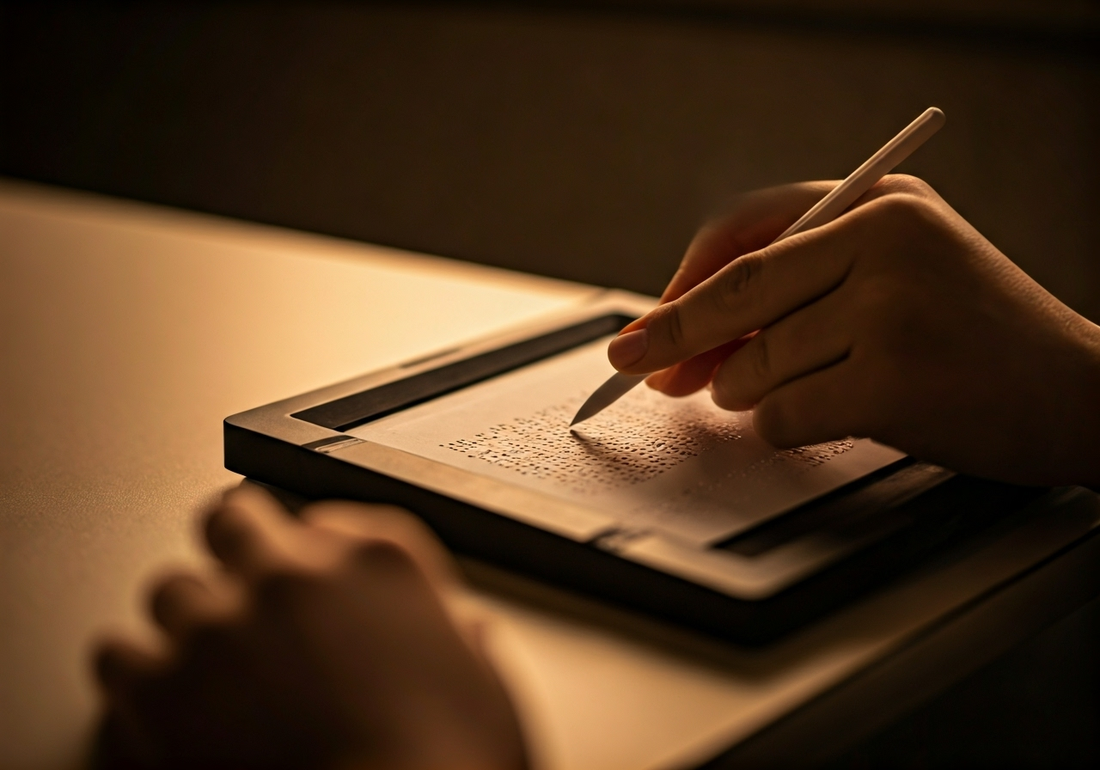Key Highlights
- A braille slate and stylus offer an affordable, hands-on method for beginners to learn braille writing techniques independently.
- The braille slate consists of two hinged pieces, often metal or plastic, which securely hold a piece of paper for tactile writing.
- Using a stylus allows users to emboss braille cells as raised dots, making written communication accessible for people who are blind or visually impaired.
- Beginners benefit from its portability, ease of use, and the opportunity to practice braille anywhere.
- Affordable options and various types of slates and styluses are widely available, especially in India, catering to different user needs and preferences.
Introduction
The braille slate and stylus remain essential tools for anyone beginning their braille journey. Invented after Louis Braille adapted the concept of "night writing," these devices transformed how people who are blind or visually impaired communicate through tactile writing. A braille slate, paired with a stylus, enables users to create raised dots on a piece of paper, making braille both accessible and personal. Whether for learning, note-taking, or daily communication, these tools continue to foster independence and literacy for beginners.
Understanding the Braille Slate and Stylus

A braille slate and stylus work together to help users manually emboss tactile dots onto paper. The slate consists of two pieces joined by a hinge, with cells designed for indentations that form braille characters. The stylus, usually with a wooden or plastic handle and a blunted metal tip, is pressed into the paper through the slate’s windows, creating the raised dots. This system, inspired by "night writing," allowed people who are blind or visually impaired to write and read their own text—an innovation that brought literacy within reach for many.
Originally, Charles Barbier’s "night writing" tool marked the beginning of this technology. Louis Braille later refined and miniaturized the design, making it practical and portable. Over time, slates and styluses have evolved, accommodating different materials and sizes to meet diverse needs, but the core principle—writing braille cells by hand—remains unchanged.
What Is a Braille Slate and Stylus Used For?
The braille slate and stylus serve as primary tools for blind or visually impaired individuals to independently write braille on a piece of paper. By aligning the paper in the slate, users press the stylus into the indentations, creating tactile dots that form braille cells. This process enables them to compose letters, numbers, and even entire documents that can be read by touch.
Unlike electronic braille note-takers or braillewriters, the slate and stylus are highly portable and need no batteries or electricity. This makes them ideal for jotting quick notes, labeling items, or learning braille writing techniques anywhere. However, learning to write braille using a slate can be challenging at first, since the embossing is done from the back and the writing direction is right to left.
Despite this limitation, the braille slate and stylus remain a cost-effective, reliable method to practice and master braille, especially for beginners who want to build a strong foundation before moving on to more advanced or digital tools.
Why Are Braille Slates Important for Beginners?
For those just starting with braille, the slate and stylus offer crucial hands-on experience. Beginners can physically feel each braille cell as they create it, reinforcing their understanding of the tactile code. This immediate feedback is vital in the early learning stages, as it links the action of making dots to reading braille.
Louis Braille’s original intention was to give individuals a way to independently write and read their own words, which the slate and stylus accomplish perfectly. Unlike braillewriters, which can be costly and bulky, slates are lightweight, affordable, and easy to carry, making them accessible for students and adults alike.
While it may take time to master the technique, especially the reverse writing direction, practicing with a braille slate helps beginners gain confidence and accuracy. The skills developed using these simple tools form the bedrock of braille literacy, empowering users to communicate effectively and independently.
Types of Braille Slates and Styluses Available in India

In India, a wide range of braille slates and styluses are available to meet diverse needs. Options include standard desktop slates, compact pocket models, and multi-line or single-line variants, each suited for different writing scenarios. Brands produce slates using materials like metal, plastic, or even wood, offering durability and comfort for users.
Choosing the right type depends on your writing habits, portability requirements, and budget. Whether for classroom use or personal note-taking, there are affordable options for every beginner. Let's explore how standard and pocket-sized slates compare next.
Standard vs. Pocket-Sized Slates
Standard and pocket-sized braille slates serve different purposes for users with varying needs. Standard slates are larger, often designed for 8.5 by 11 inch paper, and can accommodate several lines of braille cells, making them ideal for homework, longer notes, or classwork. Pocket-sized slates, on the other hand, are compact and lightweight—perfect for jotting quick notes or carrying on the go.
If you value writing space and stability, a standard slate may be the better choice. For maximum portability, pocket slates fit easily in bags or pockets and are great for short messages. Here's a comparison:
|
Feature |
Standard Braille Slate |
Pocket-Sized Braille Slate |
|---|---|---|
|
Size |
Large (8.5 by 11 inch paper) |
Small (fits in a pocket) |
|
Capacity |
Multiple lines, many cells |
Few lines, fewer cells |
|
Portability |
Bulky, less portable |
Highly portable |
|
Best For |
Homework, longer writing |
Quick notes, on-the-go writing |
Your choice will depend on how and where you plan to use your braille slate.
Materials, Brands, and How to Choose the Right Model
Braille slates are crafted from various materials, including metal for strength, plastic for lightness, and wood for a traditional feel. Renowned brands in India offer a range of slates and styluses, featuring comfortable grips and smooth embossing tips.
When buying a braille slate and stylus, consider these points:
- Material: Metal slates are durable, while plastic models are lightweight and affordable.
- Size: Choose based on your needs—standard for extended writing or pocket-sized for portability.
- Brand reputation: Established brands usually offer better build quality and customer service.
- Replacement and support: Check if spare parts or styluses are available and whether the supplier offers assistance.
Recommended brands can often be found through organizations supporting the visually impaired. Always seek guidance from experienced users or customer service to make an informed decision.
Step-by-Step Guide: Using a Braille Slate and Stylus for the First Time
Getting started with a braille slate and stylus is straightforward once you understand the basics. The process involves preparing your piece of paper, correctly positioning the slate, and using the stylus to emboss braille dots. Beginners may need a few tries to get comfortable with aligning the slate and mastering the writing direction.
Practice and patience are key—soon, you’ll be able to write braille with confidence. The following steps will guide you through setup and the best writing techniques for beginners.
Preparing Your Paper and Positioning the Slate
Before embossing braille, proper preparation ensures clean, readable dots. Begin by selecting a sturdy piece of paper suited for braille—the paper should not tear easily under pressure from the stylus.
Next, open the slate and align the paper so that the edges fit smoothly against the hinge. Close the slate so the pins or posts secure the paper, preventing movement during writing.
Keep these tips in mind:
- Align the paper with the hinge for even writing lines.
- Check the paper thickness; thin paper may tear or puncture.
- Ensure the slate clicks shut for a secure hold.
- Double-check the position before you start embossing to avoid misaligned cells.
With your paper and slate ready, you’re set to start writing.
Writing Techniques and Common Mistakes to Avoid
When embossing braille, technique matters. Hold the stylus comfortably and press firmly into the indentations, making sure each dot stands out. Remember that, when using a slate, you must write from right to left, as the dots will be read from the other side of the paper.
Many beginners encounter similar challenges, such as pressing too softly or misaligning the stylus in the windows. To avoid common mistakes:
- Use steady, even pressure to create clear, tactile dots.
- Always check your alignment before embossing each cell.
- Avoid rushing; writing too quickly can lead to errors.
- Practice writing basic braille cells before moving to sentences or paragraphs.
With regular practice, your braille writing will become accurate and consistent, making reading much easier.
Conclusion
In conclusion, a Braille slate and stylus serve as essential tools for beginners embarking on their journey to learn Braille. Not only do they enhance literacy and communication skills, but they also empower users to engage with the world around them more fully. Understanding the different types available, mastering the writing techniques, and avoiding common pitfalls are vital steps in this process. Whether you choose a standard or pocket-sized model, investing time in practice will undoubtedly lead to improved proficiency. If you're ready to dive deeper, explore various resources available in India that can support your learning experience.
Frequently Asked Questions
Where can I find affordable or free braille slates and styluses in India?
Affordable or even free braille slates and styluses are often available through organizations for the visually impaired in India. Local NGOs, schools for the blind, and government agencies may provide these tools, or you can contact customer service of specialized suppliers for low-cost options.
How do I maintain and care for my braille slate and stylus?
To ensure longevity, regularly clean your braille slate and stylus with a soft cloth to remove dust or paper residue. Handle all pieces of metal gently, store them in a protective pouch, and check for bent or dull stylus tips to preserve clear embossing.
Are there organizations in India that help beginners learn to use braille slates and styluses?
Yes, several organizations in India offer training for beginners in using braille slates and styluses. Schools for the blind, NGOs, and vision rehabilitation centers often provide hands-on instruction and support, helping new users gain confidence and proficiency in braille writing.

